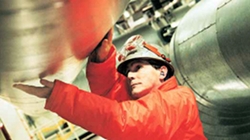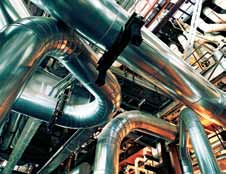by Ronald L. King — Is mechanical insulation a “forgotten technology” in your facility?
If so, you may want to start thinking more about it. A recent analysis by the U.S. Department of Energy’s Industrial Technologies Program and the National Insulation Association (NIA) estimates that implementing a comprehensive industrial mechanical insulation maintenance program — going beyond the minimum ASHRAE 90.1 2007 guidelines — in the commercial and industrial market segments would lead to:
- Energy savings of $4.8 billion per year
- CO2 reductions of 43 million metric tons (MMTCO2) per year (equal to the CO2 reductions if mature trees were planted in an area the size of Connecticut and Rhode Island combined).
“When designed, applied, and maintained properly, insulation is a powerful, long-lasting energy efficiency and emission reduction technology,” said Michele Jones, EVP/CEO of the National Insulation Association. “However, insulation is often overlooked in such initiatives, despite the fact that insulation can in many cases provide an annual return on investment of greater than 100 percent.”

Jones noted that even some facilities professionals do not recognize the difference between typical insulation that goes in walls and ceilings, and the mechanical insulation systems are used for piping, HVAC, boilers, equipment, vessels, and similar mechanical equipment in industrial and commercial applications. Mechanical insulation has at least eight important benefits: 1) reduces energy consumption and greenhouse gas emissions; 2) increases your available carbon credits; 3) enhance sustainable design initiatives, 4) improve safety programs; 5) increases manufacturing productivity, 6) eliminate or reduce corrosion under insulation, 7) control condensation and mold growth, and 8) provides an unrivaled return on your investment.
The Consequences of Ignoring Mechanical Insulation
Heat is not the only thing that is lost when mechanical insulation is neglected. Here are some other reasons to make sure your facilities regularly inspects — and when necessary replaces — mechanical insulation:
- Safety
- The condition of the insulation systems could lead to corrosion of the substrate under the insulation.
- The increased weight of wet insulation could cause the piping or equipment to exceed the structural design of the support hangers or other support systems.
- Missing or damaged insulation could create personnel safety concerns.
- Plant Environment and Regulations
- Wet insulation can contribute to the development of mold in the insulation system and adjacent areas.
- Energy Loss and Greenhouse Gas Emissions
- Missing or damaged insulation results in increased energy consumption and greenhouse gas emissions.
- Productivity
- The reduced efficiency of the insulation system does not allow supporting equipment to function as designed, resulting in decreased productivity and/or increased cost.
- Cost of Operations/Return on Investment
- Improperly designed, damaged, or failed insulation systems increase annual operating and life-cycle cost versus design or anticipated results.
“When evaluating energy efficiency options, facilities engineers should consider all these benefits and consequences in your short- and/or long-term return on investment objectives,” Jones said. “Investing in mechanical insulation maintenance could cost much less than addressing the issues that result from neglect.”
So, is mechanical insulation a “forgotten technology” in your facility? It doesn’t have to be. Jones noted that there are many resources available to help, including the National Institute of Building Sciences’ Mechanical Insulation Design Guide, a comprehensive online resource for mechanical insulation. In addition, NIA’s Certified Insulation Energy Appraisers can conduct a thorough evaluation of your facility’s mechanical insulation systems and help you identify savings opportunities.
“An insulation system failure can be costly, but it can be easily avoided,” Jones said. “Proper design, installation, and maintenance of mechanical insulation systems are not a matter of chance, compromise, or cost minimization. They are a matter of commitment and choice.”
 An inside look at the pipes of an industrial plant. Photo courtesy of the National Insulation Association
An inside look at the pipes of an industrial plant. Photo courtesy of the National Insulation Association

Benefits by the Numbers
So what do these cost and environmental savings equate to?
An energy savings of $4.8 billion per year equate to:
- 45 billion kWh of electricity, enough to power 4.2 million households
- 82 million barrels of oil, enough to fill about 41 supertankers
- 480,000,000,000,000 Btus (0.48 quadrillion Btus) of primary energy or 1.83 days of energy consumption for the entire United States.
Avoiding Mold Dangers from Your Pipe Insulation
Mold can be not only unhealthy and expensive to remediate, but in extreme cases mold hazards can cause an interruption or a complete shutdown of a facility. That is why it is vital to regularly inspect pipes and the insulation surrounding them. To help reduce or eliminate concerns over mold damage, Owens Corning recently introduced Evolution™ Paper FreeASJ (All Service Jacket) Pipe Insulation that is resistant to moisture and moisture-related damage — because without the paper, there is no food source or moisture retention for the mold to grow. Evolution™ Paper Free ASJ has a GREENGUARD® Microbial Resistance Listing.
Evolution™ Paper Free ASJ can be used the same way as standard ASJ, using standard installation tools and equipment — although it is important to use mold-resistant mastic, regardless of the type of pipe insulation you choose. Owens Corning’s Evolution™ Pipe Insulation comes in all current standard ASJ sizes. To learn more, go to http://www.evolutionpaperfree.com
CO2 reductions of 43 MMTCO2 per year equates to:
- Adding 1.9 billion mature trees (4.3 million acres of new forest, an area the size of Connecticut and Delaware combined)
- Removing 7.9 million cars from the roads, about 3 percent of 254 million cars registered in the United States
- Installing 730 million compact florescent light bulbs, equivalent to 2.3 light bulbs for every man, woman, and child in the United States.
The Importance of Maintenance
As the “forgotten technology” in many buildings, mechanical insulation is often overlooked during routine building maintenance. “It is estimated that between 10 percent and 30 percent of all installed mechanical insulation is damaged or missing, leading to a variety of issues,” Jones said. “This can lead to safety, environmental, regulatory, energy, cost — and even productivity issues. Investing in mechanical insulation maintenance could cost much less than addressing these issues.”
Ron King is a past president of the National Insulation Association (NIA) and a 45 + year veteran of the commercial and industrial insulation industry. He currently serves as a consultant to the NIA on educational, outreach, and governmental initiatives. He can be reached at RonKingRLK@aol.com.